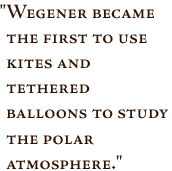

|
Alfred Wegener was born in Berlin on November 1, 1880. He studied the natural sciences at the University of Berlin, receiving a doctorate in astronomy in 1904. He did not pursue a career in astronomy, however, but turned instead to meteorology, where the telegraph, Atlantic cable, and wireless were fostering rapid advances in storm tracking and forecasting. In 1905 Wegener went to work at the Royal Prussian Aeronautical Observatory near Berlin, where he used kites and balloons to study the upper atmosphere. He also flew in hot air balloons; indeed, in 1906 he and his brother Kurt broke the world endurance record by staying aloft for more than 52 hours. Thanks to his upper-air work, Wegener was invited to join a 1906 Danish expedition to Greenland's unmapped northeast coast. He was thrilled: As a youth he had dreamed of exploring the Arctic, attracted by both the scientific and physical challenges. During this expedition Wegener became the first to use kites and tethered balloons to study the polar atmosphere.
When he returned to Germany, Wegener's Arctic research earned him a position at the small University of Marburg where, beginning in 1909, he lectured on meteorology, astronomy, and "astronomic-geographic position-fitting for explorers." Both students and professors were impressed by the clarity of the young meteorologist's thinking, by his ability to explain difficult concepts in simple terms, and by the intuitive leaps of his nimble mind. "With what ease he found his way through the most complicated work of the theoreticians, with what feeling for the important point!" a somewhat-awed colleague, physics professor Hans Benndorf, would later write. "He would often, after a long pause for reflection, say `I believe such and such' and most times he was right, as we would establish several days later after rigorous analysis." In 1911, still only 30, Wegener collected his meteorology lectures into a book, The Thermodynamics of the Atmosphere, which soon became a standard text throughout Germany. After reading it, the distinguished Russian climatologist Alexander Woeikoff wrote that a new star had risen in meteorology. In 1912, the year of his continental-drift presentations, Wegener again answered the siren call of Greenland. His four-man expedition "escaped death only by a miracle" while climbing a suddenly calving glacier on the northeast coast, then became the first to overwinter on the ice cap. The following spring, they barely survived the longest crossing of the great ice sheet ever made, traversing 750 miles of barren snow and ice rising to heights of 10,000 feet. During these perilous adventures, Wegener collected volumes of unique scientific data. The resulting publications established him as one of the world's leading experts on polar meteorology and glaciology. According to fellow meteorologist and Greenland explorer Dr. Johannes Georgi, Wegener was the first to trace storm tracks over the ice cap. When he returned to Marburg, Wegener resumed work on continental drift, marshaling all the scientific evidence he could find to support his theory. "One day a man visited me whose fine features and penetrating blue-gray eves I was unable to forget," the great German geologist Hans Cloos later recalled. "He spun out an extremely strange train of thought about the structure of the Earth and asked me whether I would be willing to help him with geological facts and concepts." Using this pioneering interdisciplinary approach, Wegener wrote one of the most influential and controversial books in the history of science: The Origin of Continents and Oceans, published in 1915. Because of the First World War, Wegener's book went unnoticed outside Germany. In 1922, however, a third (revised) edition was translated into English, French, Russian, Spanish, and Swedish, pushing Wegener's theory of continental drift to the forefront of debate in the earth sciences. next: The Origin of Continents and Oceans
|
 On the Shoulders of Giants
| ||